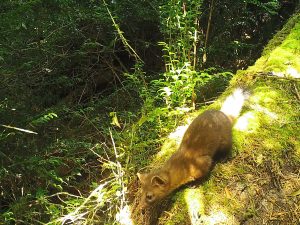STORY BY EMILY J. UHRIG
PHOTOS (EXCEPT WHERE NOTED) BY MARK LINNELL/US FOREST SERVICE PACIFIC NORTHWEST RESEARCH STATION
The coastal marten, a small, rarely seen carnivore, is at risk of extinction.
Scurrying through forests on Oregon’s central coast is a rare mammal few of us have ever seen, and with dwindling populations, one that could soon vanish entirely. Conservation efforts are underway, but not without challenges.
The coastal marten, a relative of the weasel, is a small carnivore living a rather secretive existence in forested areas of Oregon and northern California. About the size of a housecat, coastal martens can be active during any time of day, but their rarity and preference for dense shrubbery make sightings uncommon. In contrast to most martens, which tend to be found at higher elevations, the coastal subspecies lives in lower forests that get little or no snow. With these relatively milder winter seasons, there is a greater range of food resources available to coastal martens and their diet is typically broader than that of their higher elevation counterparts. Although rodents are one of their main foods, coastal martens also eat small birds, insects, and even berries. In fact, researchers sometimes use strawberry jam as bait when capturing coastal martens!
While Pacific martens are relatively common west of the Rocky Mountain crest, coastal martens are a genetically distinct subspecies limited to only four small populations. In Oregon, one population is found on the western edge of Rogue River-Siskiyou National Forest and another within the Dunes National Recreation Area on the central coast. Dr. Katie Moriarty, a longtime marten researcher currently with the National Council for Air and Stream Improvement, notes that although coastal martens occur at high densities in some areas, their populations occupy very restricted areas of habitat. Indeed, the central coast population seems to be limited to a narrow band of spruce and shore-pine forest, only around a third of a mile wide, within the dunes. Strikingly, a study by Moriarty and colleagues published in 2017 suggests current coastal marten populations are so small that losing just one or two martens could push a population beyond the point of recovery.

Today’s limited distribution of coastal martens is a marked change from their historical range, which spanned the full length of Oregon’s coast and extended south to California’s Sonoma County. The story of how coastal martens came to be at risk involves several interacting factors that, perhaps unsurprisingly, are human-caused.
As furbearers, martens have long been targets of trapping, a practice that likely drove initial population declines. In California, reduced marten harvests were noted as early as the 1920’s and marten trapping was banned in the state’s northwestern region in 1946. In Oregon, marten trapping has remained unrestricted.
The impact of trapping has been exacerbated by habitat loss. Echoing the stories of other forest-dwellers, like the spotted owl, the coastal marten’s preference for older forests means their habitat overlaps with areas subject to timber harvests. The result is that, while the fur trade’s heyday has passed, forests have contracted and coastal marten habitat has followed suit. Now confined to smaller tracts of forest, at least some populations are also isolated to the extent that martens cannot move between them. This isolation puts populations at greater risk of extinction since new individuals are not able to move in from other areas.
None of the current coastal marten populations are believed to contain more than 100 individuals, a fragility putting them at risk of other hazards less consequential for larger populations. Road mortality, for instance, is among the biggest threats to Oregon’s central coast population, according to Moriarty. Martens are territorial and an individual will frequently move throughout its patch of forest to maintain the boundaries. With busy Highway 101 bordering their habitat, road crossings pose significant hazards for coastal martens roaming their territories.
The coastal marten’s plight has been on conservationists’ radar for some time, but protecting them is a complicated endeavor that’s seen mixed results. A 2010 petition seeking protection under the federal Endangered Species Act (ESA) was unsuccessful as was a later petition for protection under Oregon’s ESA. However, environmental organizations successfully challenged the federal outcome, eventually leading to the U.S. Fish and Wildlife Service proposing to list the coastal marten as a threatened species. The listing is expected to be finalized in the fall of 2019.
 While the future of a federal listing was in limbo, conservation organizations sought another prong of protection in 2018 by petitioning for a ban on marten trapping west of Interstate 5 in Oregon. Tierra Curry, senior scientist with the Center for Biological Diversity, one of the petitioning organizations, describes coastal martens as “feisty and adorable” and notes that “…stopping trapping is something we could do immediately to help them.”
While the future of a federal listing was in limbo, conservation organizations sought another prong of protection in 2018 by petitioning for a ban on marten trapping west of Interstate 5 in Oregon. Tierra Curry, senior scientist with the Center for Biological Diversity, one of the petitioning organizations, describes coastal martens as “feisty and adorable” and notes that “…stopping trapping is something we could do immediately to help them.”
In a ruling encouraging for marten proponents, the Oregon Fish and Wildlife Commission accepted the trapping ban petition. However, the 2018 trapping season opened without restrictions, prompting the Center for Biological Diversity and Cascadia Wildlands to sue over the failure to enact the ban. “We decided to sue Oregon for allowing marten trapping because science, morality, and common sense all plainly show that they shouldn’t be trapped,” says Curry.
The lawsuit was successful and the new regulations must be in place before the 2019 trapping season. However, with marten trapping relatively uncommon in Oregon today, is the ban really that useful? Moriarty puts things into perspective, “Any mortality prevented is an opportunity to conserve.”
Some of the difficulties with securing protection for coastal martens stem simply from lack of knowledge. Not only are these elusive animals unlikely to be seen visiting backyards, they’re also great at hiding from scientists. This means certain aspects of marten biology, like details of their movement patterns, remain enigmatic. Such knowledge gaps hinder conservation efforts, underscoring the importance of further research so that more informed conservation decisions can be made.
Beyond the legislative arena, one major benefit to conservation is public support. However, that’s more easily garnered for well-known animals like bald eagles or whales. For species whose existence generally goes unnoticed, questions of why anyone should care often arise. For coastal martens, one practical answer lies in their importance as ecosystem members helping keep prey species in check. Another, more philosophical, answer is that human activities got them into their current predicament so perhaps we have some responsibility to help them recover. ■
Story Updates (May 2020): The Oregon Department of Fish and Wildlife banned trapping of the coastal marten within the Oregon Dunes National Recreation Area and the Siskiyou and Siuslaw national forests.
U.S. Fish and Wildlife Service has determined that the coastal distinct population segment of the Pacific marten, known as the coastal marten, warrants listing as a threatened species under the Endangered Species Act(ESA). (updated September 2020)

This story appeared in the Summer 2019 issue of Oregon Coast magazine.




